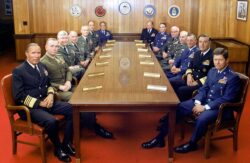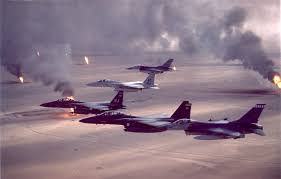U.S. Defense Policy
US Defense Posture in Global Context: a framework for evaluating the Quadrennial Defense Review
Asia Pacific Tilts to West: Limit Offensive Weaponry, Boost Arms Control
by Carl Conetta and Charles Knight, commentary originally published in Defense News, 31 March – 06 April 1997.
➪ HTML
Examines the pattern of military spending in the Asia Pacific region since the Cold War and makes recommendations for U.S. policy. Based on data and analysis from Post-Cold War US Military Expenditure in the Context of World Spending Trends.
Framework for Constructing a “New Era” Alternative to the Bottom-Up Review
➪ HTML
Based on the strategic objective of a core area coalition defense (i.e. Persian Gulf, Korea, and Europe) this memo takes the reader step by step through the logic of force sizing and structuring and modernization requirements to arrive at a robust and consistent alternative to the Bottom-Up Review force posture.
Post-Cold War US Military Expenditure in the Context of World Spending Trends
by Carl Conetta and Charles Knight, PDA Briefing Memo #10, January 1997.
➪ HTML
➪ summary
Based on a review of official world military spending data, this study finds evidence that the strategic position of the US and its allies has improved immensely relative to the potential threat states. It also looks at regional trends and offers a perspective on the new and ambitious regional military strategy of the U.S.
The Development of America’s post-Cold War Military Posture: A Critical Appraisal
By Carl Conetta, 07 November 1996.
➪ HTML
➪ PDF
This article outlines the factors influencing and distorting military planning (with special attention to the 1992-1996 period.)
 In the early years of the post-Cold War era, the US defense establishment set out to formulate a new military posture. This was supposed to reflect the new strategic environment and pursue the opportunities afforded by advances in information technology. The result, however, was a “new” posture closely resembling the old, writ somewhat smaller. It was to be progressively bolstered by cutting-edge technology inputs. However, while remarkably expensive, these inputs would only partially fulfill their promise, while exhibiting varying degrees of reliability and sustainability. Soon the USA would be spending as much and more inflation-adjusted dollars on its armed forces as during the Cold War. Also driving requirements and budgets upward would be the adoption of new strategic goals, roles, and missions exceeding those of the Cold War period.
In the early years of the post-Cold War era, the US defense establishment set out to formulate a new military posture. This was supposed to reflect the new strategic environment and pursue the opportunities afforded by advances in information technology. The result, however, was a “new” posture closely resembling the old, writ somewhat smaller. It was to be progressively bolstered by cutting-edge technology inputs. However, while remarkably expensive, these inputs would only partially fulfill their promise, while exhibiting varying degrees of reliability and sustainability. Soon the USA would be spending as much and more inflation-adjusted dollars on its armed forces as during the Cold War. Also driving requirements and budgets upward would be the adoption of new strategic goals, roles, and missions exceeding those of the Cold War period.
Over subsequent decades, the tension between purported military requirements and resources constraints would grow acute, while the armed forces found themselves over-extended worldwide and mired in seemingly endless wars, despite their presumed (and costly) advantages. How did US defense policy come to this point? The Development of America’s post-Cold War Military Posture shows how dysfunctional planning assumptions and processes can easily lead to dysfunctional policy.
Nonoffensive Defense and the Transformation of US Defense Posture: Is Nonoffensive Defense Compatible with Global Power?
Air Power Promises and Modernization Trends after Operation Desert Storm
by Alan Bloomgarden and Carl Conetta, Dec 1994.
➪ HTML
➪ PDF
This article first appeared in 1994 in a slightly edited form in Hawk Journal, the annual publication of the Royal Air Force Staff College.
The expectation of an airpower revolution began in earnest soon after victory in the first US-Iraq Gulf War, 1990-1991. Drawing extensively on official and outside expert assessment of airpower in “Operation Desert Storm,” this article critically reviews the evidence for an airpower revolution while summarizing a range of contemporary opinions on the issue.
Specifically, the article examines three claims advanced by airpower enthusiasts at the dawn of the post-Cold War period: that the Gulf War experience suggests greatly expanded options for limited-aims “raiding missions,” strategic bombing campaigns, and airpower dominance over the ground battle (using improved battlefield interdiction and close air support.)
Included are summaries of the extensive Gulf War Air Power Survey and other surveys of the war which provide an unsurpassed view of the war’s dynamics. It also examines the technologies, contemporary and in development, central to the putative airpower revolution.

The Left and the Military
by Charles Knight
originally published in Dissent magazine, Fall 1994.
This article argues that if the American left seeks to influence state policy, it must do much more than reflexively criticize U.S. military policy. Instead, it must engage with critical debates in the field from an informed stance that both criticizes and presents a coherent set of counter-policies with which it can attract the growing support of the American people over time. This article proposes both principles and select particulars for this counter-policy.
Despite the left’s consistent attention to military matters, it lacks a coherent approach to military policy. Mostly, the left has an inclination toward military issues — and that inclination has been fairly consistently anti-military. This does not preclude banging the drum occasionally for select interventions. But it does mean that whenever the left relates to military policy, it relates as an outsider; it relates as though the realm of military policy is unremittingly hostile to progressive values. This article will argue that a positive progressive military policy is both possible and necessary — necessary both to achieve progressive goals and to the credibility of the left in American politics.
Mismatch: The “Bottom Up Review” and America’s Security Requirements in the New Era
➪ HTML
Build-Down: US Armed Forces Retrenchment in the Context of Modernization
➪ HTML
A detailed examination of how current military modernization programs will interact with planned force reductions in shaping America’s future armed forces. The report looks beyond superficial indicators of change to suggest the real, net effect of the current policy on the nation’s military capability.
Free Reign for the Sole Superpower?
Rand’s ‘New Calculus’ and the Impasse of US Defense Restructuring
Reviews a key planning study contributing to US post-Cold War strategic thinking and force planning, revealing critical shortcomings in the planning scenarios and simulations that continue to shape US defense policy. Individual sections address the “two war” standard of sufficiency, the persistence of “Central Front” logic, and assessments of the requirements for strategic airlift and combat aircraft modernization.
Toward Defensive Restructuring in the Middle East
by Carl Conetta, Charles Knight, and Lutz Unterseher, PDA Research Monograph #1, February 1991.
➪ HTML ➪ PDF

Examines the character of force structure and military conflict in the Middle East and outlines a nonoffensive defense posture for nations in the region. It also draws the implications of such a posture for arms transfers and arms control policy. An appendix reviews the pertinent lessons of the 1990-91 Gulf War.
Joint US-Soviet Seminar on Conventional Arms Reductions in Europe
by Carl Conetta, Conference Report, in Defense and Disarmament Alternatives, the newsletter of the Institute for Defense and Disarmament Studies (IDDS), January 1989.
 Report on the September 1988 conference, co-hosted by the Institute for World Economy and International Relations (IMEMO) and Institute for Defense and Disarmament Studies (IDDS), of Soviet and US arms control and military policy specialists. The report summarizes the exchange regarding problems and prospects for conventional force reductions in Europe.
Report on the September 1988 conference, co-hosted by the Institute for World Economy and International Relations (IMEMO) and Institute for Defense and Disarmament Studies (IDDS), of Soviet and US arms control and military policy specialists. The report summarizes the exchange regarding problems and prospects for conventional force reductions in Europe.
These meetings happened a little less than two months before President Gorbachev’s historic announcement at the UN in December of 1988 of substantial unilateral reductions and defensive restructuring of Soviet troops in eastern Europe – one of the most significant policy shifts in the process of ending the European Cold War. This international conference likely had more import than most.
The Sometimes You Win and Sometimes You Lose Hypothesis: Some Comments on the Use of Models in Force Comparisons
by Charles Knight, 18 March 1988. PDF
In this previously unpublished paper from 1988, the author reviews various models for simulating war along the Central Front in Germany and their relevance for finding a stable conventional force balance in Europe (and elsewhere.) Force structures that tend to produce stable outcomes in battlefield simulations are likely to have more deterrent value in the real world.
“[C]omplex models [can] be very useful in distinguishing the conditions (i.e. force structures, tactics, and armaments) that produce chaotic, oscillating, or unstable outcomes from those that produce stable outcomes.
“The outcome of a conflict between balanced forces as currently structured is unknowable and unpredictable. This would seem to support the position that no stable conventional deterrent to war can be built, short of overwhelming superiority. If that was as far as our analysis went, we [might] end up giving support to flexible response doctrine with its fundamentally unstable nuclear deterrent component. Of course, the favored option is to model restructured conventional forces that can take us out of the chaotic conventional battlefield and give us stable outcomes.”

